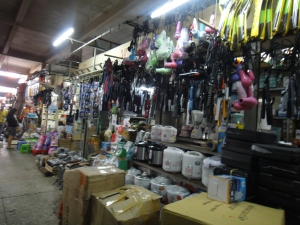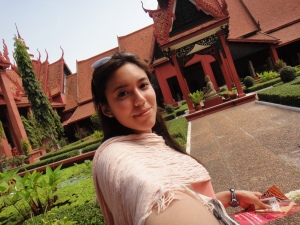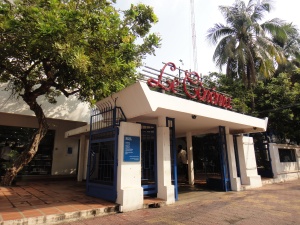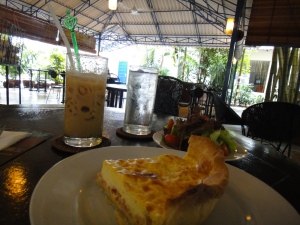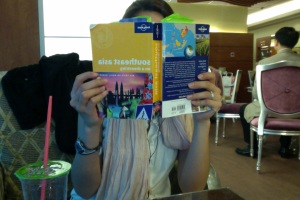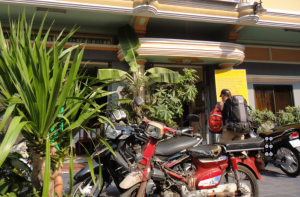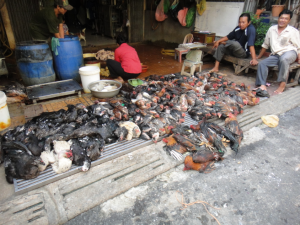Traveling by land, exploring the outskirts of Phnom Penh, 7 hours later I arrive in Kratie Province. Last weekend, I explored a northern province of Cambodia and visited Cambodian Rural Development Team’s GlobalGiving Project to Provide renewable energy to 15 families in a rural village on Koh Pdao Island separated not only by income but also by rivers from society and the main markets.
Finally, Monday arrived and I was able to visit Cambodian Rural Development Team’s project…
My day began meeting Mr. Bin Dim, the project manager, in Sambor province and off we were to board a ferry to Koh Pdao Island. The villages that we were off to visit are on an island and the main source of income included the selling of animals and agriculture. When we arrived, the area was hot and dry. Cows and water buffalo roamed free and the pace of life was definitely a lot slower than just across the river. We arrived at the first beneficiary family’s home. It consisted of a widow and her 6 family members.
One of the daughters welcomed us into their home, immediately recognizing and so happy to see Bin. Bin showed me the outside biodigester that they installed on behalf of the funding raised via GlobalGiving. This was one of 15 families that received them. Then the daughter and Bin proceeded to show me how it worked and she explained how she used it. I then asked her what she used before this gas resource – and she said batteries. Before, the family had to take the batteries into town across the river to pay to recharge them constantly. Also the family used wood to cook so had to go chop trees in the forest, using valuable time they could be spending on farming and helping out in community. Cooking with wood also created a lot of smoke making the place dirty, she said. I also immediately thought that it probably was not good for their health either. Finally I asked her how the gas has benefited her family, and she replied that now when she needs to boil water or cook dinner all she needs to do is turn on the gas light the pilot and put the water or food on. It is so easy and now they have time to focus on work [income generating activities].
We went on to visit many other families all with the same explanations of how much the gas system has made things easier. I asked where they get the manure though if they don’t raise cattle or pigs, and they responded that they are able to collect extra from neighbors. These communities I found out are extremely communal. They even decide what each family will grow or make based on the needs of the village during community meetings. This is how CRDT works within the communities – speaking with the village leaders and villagers identifying needs and obstacles to their ability to focus on activities that will support income and raise the standard of living.
One other need CRDT recognized was for sanitation –due to no running water and electricity, organizations along with CRDT such as Oxfam have stepped in to provide fishing ponds, toilets, hygiene and health awareness campaigns and trainings, animal husbandry trainings, incinerators to get rid of “rubbish”, environmental education programs, and now looking into irrigation. Also, CRDT has started an ecotourism project that brings tourists to spend a few days within the village working and living alongside families in homestays. This is to promote income for the villages as well as cultural learning for both sides.
About the Biodigesters:
Who gets these biodigesters? A lottery system was put into place to determine who in the villages received the first batch of biodigesters. One widow exclaimed after being chosen that she was “very lucky.”
How do they work? Biodigesters take manure and turn it into natural gas that can be used for cooking and electricity.
Why is this important? Families can spend less time destroying the local forest, and injuring their health inhaling smoke while cooking. Children can study at night due to electric lights from the gas system; the source of energy comes right from their own animals that they raise and use for food, income, and transportation. The day and productivity no longer ends when the sun goes down and they have run out of batteries or candles. Time spent waiting for food to cook over wood fires is now spent doing other productive activities.
At the end, Bin Dim and I sat down to have a home cooked lunch of fried fish, banana chips, rice, and noodles with egg and vegetables. An older woman and husband in one of the homestay locations hosted us. They both had many questions for me such as where I come from, what life is like there, if people in US move out at 18 and are independent generally in adulthood… then who decides what your career is and decision making when get married? You decide for yourself I replied. And they were pleasantly surprised. Many other questions went on including how old are was I, and if I knew anyone in Georgia. They did not know Texas – but Georgia they knew because they had heard of Cambodian families moving there. Finally, they wanted to know about the 9/11 disaster, terrorism, why USA was attacked, and then finally wanted to show me all of the gifts they received from their many international visitors – gifts from Australia and even… Idaho!
Before I left the husband stopped me to say – thank you. Thank you for supporting CRDT so that they can help the villages.

 The Friends Educational and Training Center
The Friends Educational and Training Center 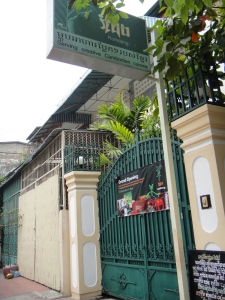
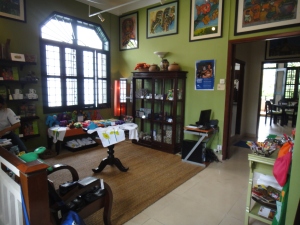


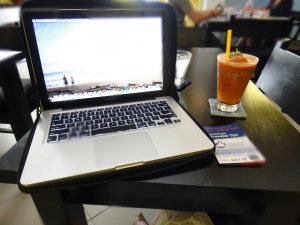 Getting work done at Friends Restaurant while having a non-alcoholic Passion Fruit chiller, reading the ChildSafe pamphlet, and about to taste the tuna and egg salad (YUM)
Getting work done at Friends Restaurant while having a non-alcoholic Passion Fruit chiller, reading the ChildSafe pamphlet, and about to taste the tuna and egg salad (YUM)

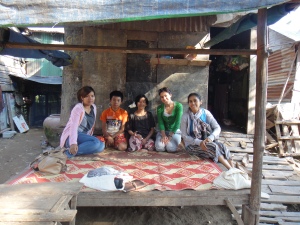 With Pirron, his grandmother, and FSP staff at their home
With Pirron, his grandmother, and FSP staff at their home Holding Smile’s Angry Birds Drawings
Holding Smile’s Angry Birds Drawings Sharing fruit with mother and son during home-visit
Sharing fruit with mother and son during home-visit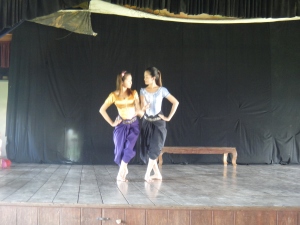



 Me attempting Cambodian Dance
Me attempting Cambodian Dance

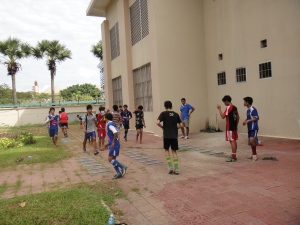
 The girls’ team: one ran up to me, said hello, asked my name, and proudly proclaimed she wanted to play football when she grew up. Then ran off to play again. They were all full of laughter and joy.
The girls’ team: one ran up to me, said hello, asked my name, and proudly proclaimed she wanted to play football when she grew up. Then ran off to play again. They were all full of laughter and joy.

